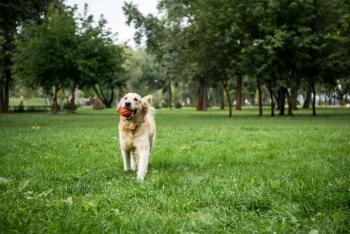
Diagnostic dilemmas in parasitology (Proceedings)
Most parasitologic diagnoses are straightforward, but there are several situations where making diagnosis of parasitic infection or disease is more difficult and potentially confusing.
Most parasitologic diagnoses are straightforward, but there are several situations where making diagnosis of parasitic infection or disease is more difficult and potentially confusing.
Two of the common diagnostic dilemmas encountered by practitioners in the U.S. are associated with the use of antigen tests. The first is the occurrence of a positive heartworm antigen test in a clinically normal animal. Repeating the test in your practice can eliminate the possibility of test performance error or sample switching. But confirmation should be sought even if the second test is positive if there is no clinical evidence of heartworm based on signs or imaging techniques. It can be very helpful in these cases to send a sample to a university or commercial laboratory that uses an antigen test made by a different manufacturer.
Interpreting the results of consistently positive Giardia antigen tests in clinically normal animals can also be source of frustration for owners and practitioners. The natural history of Giardia infection is poorly understood in dogs. Some animals appear to be more susceptible than others and may be readily reinfected or more difficult to clear with treatment. The Companion Animal Parasite Council recommends using antigen tests in combination with other methods of Giardia detection to diagnose infection in symptomatic animals.
Isospora coocidia infections of small animals are quite common, especially in kittens and puppies and these infections may cause diarrhea in animals that are stressed by weaning, changing homes, etc. The diarrhea caused by coccidia in small animals is typically seen in young animals and is an acute problem that, in immmuno-competent animals, should be self-limiting. The recently adopted kitten or puppy with diarrhea and numerous oocysts in a fecal exam can reasonably be diagnosed as having coccidiosis.
More problematic is an adult animal with diarrhea and coccidia oocysts in the feces. Most dogs and cats get exposed to coccidia as young animals and, even though they may continue to shed some oocysts intermittently throughout life, it is assumed that the immune response makes them resistant to clinical disease. In particular, chronic diarrhea in an adult animal will not be a consequence of coccidia infection alone. So whenever an identification of “coccidia” is presented on fecal exam results, it is important to ask if the coccidia are, in fact, Isospora and not Eimeria or other species of non-small animal coccidia.
Dogs that eat feces and dogs and cats that have the opportunity to scavenge or hunt may ingest coccidia species of other animals that pass through the canine and feline GI tract and are passed unchanged in the feces and are considered “spurious” parasites (i.e., true parasites of one animal species that are found in the feces of another animal because of coprophagy or predation.) The presence of spurious oocysts is probably due most often to coprophagy by dogs. Ruminant manure as well as rabbit, bird, squirrel and other animal feces often contain coccidian occysts, usually from the genus Eimeria (an exception is horses, which rarely have coccidia oocysts in the manure). Isospora and Eimeria oocysts cannot always be distinguished. However, there are two helpful characteristics that may allow the genus to be identified. Eimeria oocysts sometimes have a cap at one end of the oocyst that shows up as a small knob. This knob covers the micropyle, which is where the coccidian sporozoites will emerge from the oocyst. Isospora oocysts never have the knob at one end of the oocyst.
Secondly, if Isospora oocysts are exposed to the external environment they will begin to divide. On a warm day, if the fecal sample isn't picked up for a few hours or sits at room temperature for several hours, a cell division occurs inside the oocyst. If these oocysts are subsequently seen on a fecal exam and have 2 cells, this represents the first cell division and the oocysts are Isospora. When Eimeria oocysts undergo their first cell division, the resulting oocyst will contain 4 cells and Eimeria is never seen in a 2-cell stage. Owners should be asked in their animals have the opportunity to ingest coccidia of another animal. If so, or if you suspect that you are seeing spourous parasites, it is best to wait a day or two and then repeat the fecal exam. In the case of a dog eating feline feces containing oocysts, it is not possible to differentiate between dog and cat species of Isospora.
Another diagnostic dilemma that can arise is the identification of nematode larvae in a Baermann test for larvae or on a fecal flotation test. Nematodes can be present either as a result of some parasitic infections or because the fecal sample was allowed to sit in the environment and hookworm eggs have hatched or the sample was invaded by free living nematodes (of which there are billions/acre of arable land). In a case of substantial contamination with free-living nematodes, a number of life stages may be present and the size variation between the stages is clearly evident and adult females usually have eggs present in the uterus. However, free living nematodes and hatched hookworm eggs can be eliminated by insisting on a fresh fecal samples that is collected immediately after hitting the ground. For cats that use a litter box, the box should be cleaned and then the next sample collected as quickly as possible afterward.
Identification of larvae may seem daunting, but is not especially difficult and can be successfully performed in your practice. First, it will be necessary to kill the worms to look at them more closely. The easiest and best way to kill the larvae is to use Lugol's iodine so that the larvae will die lying straight. Ten percent formalin and 70% alcohol also kill larvae, but usually in a coiled position. In cats, it is only necessary to look at the tail of the now immobile larva. If it has a kink and an extra spine, the larva is Aelurostrongylus, a lungworm. For dogs, it is a little more complicated.
Once the larva is dead, the shape of the esophagus can be examined and while this sounds esoteric, in fact, it is not that difficult to determine if there is a long, generally straight tube leading to the intestine or if the tube has a conspicuous bulb at the end. If there is a bulb on the esophagus it is either a free living larva, a hatched hookworm egg or a Strongyloides larva in dogs. The first 2 alternatives can be eliminated if it is a fresh fecal sample. Strongylides larvae are the parasite larvae most likely to be found in canine feces. If the esophagus lacks a bulb, then the options (Angiostrongylus, Filaroides, Crensosoma) can be identified using the shape of the tail.
.*Strongyloides in cats very rare in U.S
References
Bowman D, Little SE, Lorentzen L, Shields J, Sulliva MP, Carlin EP. 2009. Prevalence and geographic distribution of Dirofilaria immitis, Borrelia burdorferi, Ehrlichia canis, and Anaplasma phagocytophilum in dogs in the United States: Results of a national clinic-based serologic survey. Vet. Parasitology 160:138-148.
Companion Animal Parasite Council. Recommendations on Giardiasis, August , 2011.
Zajac AM, Conboy GA. 2006. Veterinary Clinical Parasitology, 7th ed. Ams IA. Blackwell Publishing.
Newsletter
From exam room tips to practice management insights, get trusted veterinary news delivered straight to your inbox—subscribe to dvm360.





